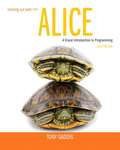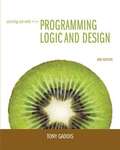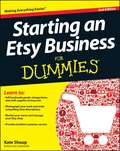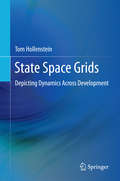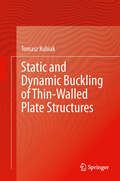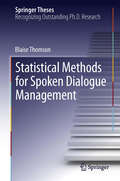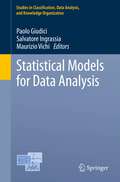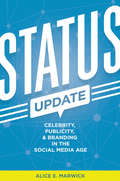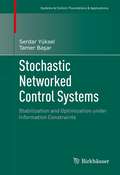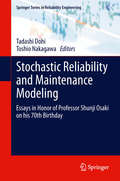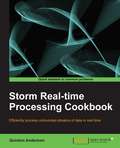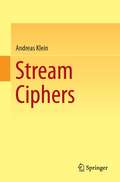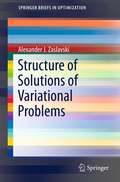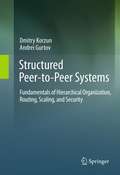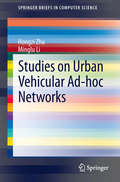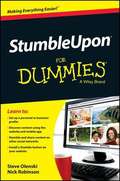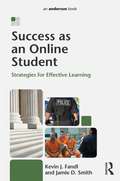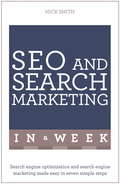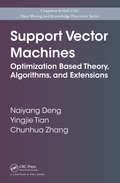- Table View
- List View
Starting Out with Alice: A Visual Introduction to Programming
by Tony GaddisStarting Out with Alice: A Visual Introduction to Programming presents a fun and motivational way for novice programmers to learn the basic tenets of programming. Using Alice, an innovative and increasingly popular teaching tool, readers from a variety of backgrounds create virtual programming worlds of animations and computer games. In the successful style of Tony Gaddis' texts, useful examples and detail-oriented explanations allow students to become comfortable with fundamental concepts of programming without dealing with frustrating syntax errors and complex design techniques. With the knowledge acquired using Alice, students gain confidence in their skills to transition into Java or other programming languages.
Starting Out with Programming Logic and Design (Third Edition)
by Tony GaddisA language independent programming guide aimed at equipping students with sound fundamental knowledge on logical thinking without the complication of language syntaxes.
Starting Your Career as a Professional Blogger (Starting Your Career)
by Jacqueline BodnarWith traffic to personal blogs and online journalism sites on the rise, there are more blogging opportunities than ever before. With the right approach, a blog can be an extra source of cash, or it can be a business unto itself yielding thousands of dollars a week, all earned on your own schedule, from the comfort of your home office, and writing about the topic of your choice. If that sounds too good to be true, this invaluable book will prove to you that it can be done. Unlike other guides, Starting Your Career as a Professional Blogger goes beyond the basics to show you how to earn a living while doing what you love. Experienced blogger Jacqueline Bodnar takes offers a comprehensive overview of the blogging world, presenting effective strategies for establishing a web presence and marketing your work. Topics include: Choosing a niche Knowing the advantages of different blogging platforms (WordPress, Tumblr, etc.) Setting up, maintaining, and monetizing your blogIncreasing traffic to your blog Finding your audience--and helping them find you Vlogging Promoting your blogNetworking with other bloggers Creating a podcast Synching your blog with your social networking accountsAnd more If you've ever wanted to write for a living, this book will help you achieve your dream, on your own terms. Welcome to the blogosphere!
Starting an Etsy Business For Dummies
by Kate Shoup Kate GatskiThe easy way to build an online craft business from scratchStarting an Etsy Business For Dummies offers expert advice for artists and entrepreneurs looking to build an online craft business from scratch. You'll get invaluable information on how to set up an Etsy shop, write compelling item descriptions, photograph your work, engage the Etsy community, understand fees, and find your muse when it takes a holiday.In the last couple of years, the DIY movement has transcended the big-box hardware stores, and has taken on a new format in the savvy crafting arena. Starting an Etsy Business For Dummies shows you how to create, manage, and successfully sell handmade wares, vintage goods, and DIY supplies using the world's largest online handmade marketplace.Coverage new to this edition includes the latest in flash sale partners; best practices for applying SEO to your shop and listings; new tools for sellers; and much moreIncludes tips for increasing local sales by connecting with other local vendors through seller communitiesCovers harnessing the power of Pinterest to promote (and protect) your businessIf DIY is your domain, Starting an Etsy Business For Dummies gives you the skills, knowledge, and know-how to create a successful business that pays.
State Space Grids
by Tom HollensteinHuman development from birth through adulthood is a complex interplay of many interacting forces. Children's internal processes are manifest in behaviors that are sculpted by their experiences, most notably with primary caregivers. Because the discipline of psychology explores human behavior and cognition, the techniques employed for developmental analysis must be able to describe, depict, and quantify these complex processes. State Space Grids provides the framework, basic method, rationale, and advanced techniques for translating the behavior of children, adolescents, and parents into visible, traceable data. This seminar-between-covers takes readers step by step from conceptualization through implementation of projects, with examples from a range of current research within and outside child development. Links are included for the GridWare software program and related user resources. And although state space grids need not be used only to analyze dynamic systems, they serve as an excellent tool for honing systemic thinking. Key coverage in this volume includes: Dynamic systems and the origins of state space grids. The state of research using state space grids. Introducing GridWare and how it works. How to use state space grids, from idea through finished project. Within-grid and between-grid analysis. Conducting advanced analysis. State Space Grids is an essential reference for researchers across such disciplines as psychology, neuroscience, economics, computer science, and agricultural science.
Static and Dynamic Buckling of Thin-Walled Plate Structures
by Tomasz KubiakThis monograph deals with buckling and postbuckling behavior of thin plates and thin-walled structures with flat wall subjected to static and dynamic load. The investigations are carried out in elastic range. The basic assumption here is the thin plate theory. This method is used to determination the buckling load and postbuckling analysis of thin-walled structures subjected to static and dynamic load. The book introduces two methods for static and dynamic buckling investigation which allow for a wider understanding of the phenomenon. Two different methods also can allow uncoupling of the phenomena occurring at the same time and attempt to estimate their impact on the final result. A general mathematical model, adopted in proposed analytical-numerical method, enables the consideration of all types of stability loss i.e.local, global and interactive forms of buckling. The applied numerical-numerical method includes adjacent of walls, shear-lag phenomenon and a deplanation of cross-sections.
Statistical Methods for Spoken Dialogue Management
by Blaise ThomsonSpeech is the most natural mode of communication and yet attempts to build systems which support robust habitable conversations between a human and a machine have so far had only limited success. A key reason is that current systems treat speech input as equivalent to a keyboard or mouse, and behaviour is controlled by predefined scripts that try to anticipate what the user will say and act accordingly. But speech recognisers make many errors and humans are not predictable; the result is systems which are difficult to design and fragile in use. Statistical methods for spoken dialogue management takes a radically different view. It treats dialogue as the problem of inferring a user's intentions based on what is said. The dialogue is modelled as a probabilistic network and the input speech acts are observations that provide evidence for performing Bayesian inference. The result is a system which is much more robust to speech recognition errors and for which a dialogue strategy can be learned automatically using reinforcement learning. The thesis describes both the architecture, the algorithms needed for fast real-time inference over very large networks, model parameter estimation and policy optimisation. This ground-breaking work will be of interest both to practitioners in spoken dialogue systems and to cognitive scientists interested in models of human behaviour.
Statistical Models for Data Analysis
by Paolo Giudici Maurizio Vichi Salvatore IngrassiaThe papers in this book cover issues related to the development of novel statistical models for the analysis of data. They offer solutions for relevant problems in statistical data analysis and contain the explicit derivation of the proposed models as well as their implementation. The book assembles the selected and refereed proceedings of the biannual conference of the Italian Classification and Data Analysis Group (CLADAG), a section of the Italian Statistical Society.
Status Update
by Alice E. MarwickSocial media technologies such as YouTube, Twitter, and Facebook promised a new participatory online culture. Yet, technology insider Alice Marwick contends in this insightful book, "Web 2.0" only encouraged a preoccupation with status and attention. Her original research--which includes conversations with entrepreneurs, Internet celebrities, and Silicon Valley journalists--explores the culture and ideology of San Francisco's tech community in the period between the dot com boom and the App store, when the city was the world's center of social media development. Marwick argues that early revolutionary goals have failed to materialize: while many continue to view social media as democratic, these technologies instead turn users into marketers and self-promoters, and leave technology companies poised to violate privacy and to prioritize profits over participation. Marwick analyzes status-building techniques--such as self-branding, micro-celebrity, and life-streaming--to show that Web 2.0 did not provide a cultural revolution, but only furthered inequality and reinforced traditional social stratification, demarcated by race, class, and gender.
Steve Jobs
by Nick HunterHow has Apple Inc. come to dominate the technology industry? This book looks at the life of Steve Jobs, with a focus on how he became successful.
Stochastic Geometry for Wireless Networks
by Martin HaenggiCovering point process theory, random geometric graphs and coverage processes, this rigorous introduction to stochastic geometry will enable you to obtain powerful, general estimates and bounds of wireless network performance and make good design choices for future wireless architectures and protocols that efficiently manage interference effects. Practical engineering applications are integrated with mathematical theory, with an understanding of probability the only prerequisite. At the same time, stochastic geometry is connected to percolation theory and the theory of random geometric graphs and accompanied by a brief introduction to the R statistical computing language. Combining theory and hands-on analytical techniques with practical examples and exercises, this is a comprehensive guide to the spatial stochastic models essential for modelling and analysis of wireless network performance.
Stochastic Networked Control Systems
by Tamer Başar Serdar YükselNetworked control systems are increasingly ubiquitous today, with applications ranging from vehicle communication and adaptive power grids to space exploration and economics. The optimal design of such systems presents major challenges, requiring tools from various disciplines within applied mathematics such as decentralized control, stochastic control, information theory, and quantization. A thorough, self-contained book, Stochastic Networked Control Systems: Stabilization and Optimization under Information Constraints aims to connect these diverse disciplines with precision and rigor, while conveying design guidelines to controller architects. Unique in the literature, it lays a comprehensive theoretical foundation for the study of networked control systems, and introduces an array of concrete tools for work in the field. Salient features included: · Characterization, comparison and optimal design of information structures in static and dynamic teams. Operational, structural and topological properties of information structures in optimal decision making, with a systematic program for generating optimal encoding and control policies. The notion of signaling, and its utilization in stabilization and optimization of decentralized control systems. · Presentation of mathematical methods for stochastic stability of networked control systems using random-time, state-dependent drift conditions and martingale methods. · Characterization and study of information channels leading to various forms of stochastic stability such as stationarity, ergodicity, and quadratic stability; and connections with information and quantization theories. Analysis of various classes of centralized and decentralized control systems. · Jointly optimal design of encoding and control policies over various information channels and under general optimization criteria, including a detailed coverage of linear-quadratic-Gaussian models. · Decentralized agreement and dynamic optimization under information constraints. This monograph is geared toward a broad audience of academic and industrial researchers interested in control theory, information theory, optimization, economics, and applied mathematics. It could likewise serve as a supplemental graduate text. The reader is expected to have some familiarity with linear systems, stochastic processes, and Markov chains, but the necessary background can also be acquired in part through the four appendices included at the end. · Characterization, comparison and optimal design of information structures in static and dynamic teams. Operational, structural and topological properties of information structures in optimal decision making, with a systematic program for generating optimal encoding and control policies. The notion of signaling, and its utilization in stabilization and optimization of decentralized control systems. · Presentation of mathematical methods for stochastic stability of networked control systems using random-time, state-dependent drift conditions and martingale methods. · Characterization and study of information channels leading to various forms of stochastic stability such as stationarity, ergodicity, and quadratic stability; and connections with information and quantization theories. Analysis of various classes of centralized and decentralized control systems. · Jointly optimal design of encoding and control policies over various information channels and under general optimization criteria, including a detailed coverage of linear-quadratic-Gaussian models. · Decentralized agreement and dynamic optimization under information constraints. This monograph is geared toward a broad audience of academic and industrial researchers interested in control theory, information theory, optimization, economics, and applied mathematics. It could likewise serve as a supplemental graduate text. The reader is expected to have some familiarity with linear systems, stochastic processes, and Markov chai...
Stochastic Reliability and Maintenance Modeling
by Toshio Nakagawa Tadashi DohiIn honor of the work of Professor Shunji Osaki, Stochastic Reliability and Maintenance Modeling provides a comprehensive study of the legacy of and ongoing research in stochastic reliability and maintenance modeling. Including associated application areas such as dependable computing, performance evaluation, software engineering, communication engineering, distinguished researchers review and build on the contributions over the last four decades by Professor Shunji Osaki. Fundamental yet significant research results are presented and discussed clearly alongside new ideas and topics on stochastic reliability and maintenance modeling to inspire future research. Across 15 chapters readers gain the knowledge and understanding to apply reliability and maintenance theory to computer and communication systems. Stochastic Reliability and Maintenance Modeling is ideal for graduate students and researchers in reliability engineering, and workers, managers and engineers engaged in computer, maintenance and management works.
Storm Real-Time Processing Cookbook
by Quinton AndersonA Cookbook with plenty of practical recipes for different uses of Storm.If you are a Java developer with basic knowledge of real-time processing and would like to learn Storm to process unbounded streams of data in real time, then this book is for you.
Straight Flush: The True Story of Six College Friends Who Dealt Their Way to a Billion-dollar Online Poker Empire and How It All Came Crashing Down...
by Ben MezrichFrom the New York Times bestselling author of The Accidental Billionaires and Bringing Down the House--the sources for the films The Social Network and 21--comes the larger-than-life true tale of a group of American college buddies who brilliantly built a billion-dollar online poker colossus based out of the hedonistic paradise of Costa Rica. One problem: the U. S. Department of Justice was gunning for them. . . . Based on extensive insider interviews and participation, acclaimed author Ben Mezrichs Straight Flush tells the captivating rags-to-riches tale of a group of University of Montana frat brothers who turned a weekly poker game in the basement of a local dive bar into AbsolutePoker. com, one of the largest online companies in the world, on par with some of the behemoths of the Internet. At its height, Absolute Poker was an online empire earning more than a million dollars a day, following savvy business strategy and even better luck. Its founders set up their operations in the exotic jungle paradise of Costa Rica, embracing an outrageous lifestyle of girls, parties, and money. Meanwhile, the gray area of U. S. and international law in which the company operated was becoming a lot more risky, and soon the U. S. Department of Justice had placed a bulls-eye on Absolute Poker. Should they fold--or double down and ride their hot hand? Impossible to put down, Straight Flush is an exclusive, never-before-seen look behind the headlines of one of the wildest business stories of the past decade.
Stream Ciphers
by Andreas KleinIn cryptography, ciphers is the technical term for encryption and decryption algorithms. They are an important sub-family that features high speed and easy implementation and are an essential part of wireless internet and mobile phones. Unlike block ciphers, stream ciphers work on single bits or single words and need to maintain an internal state to change the cipher at each step. Typically stream ciphers can reach higher speeds than block ciphers but they can be more vulnerable to attack. Here, mathematics comes into play. Number theory, algebra and statistics are the key to a better understanding of stream ciphers and essential for an informed decision on their safety. Since the theory is less developed, stream ciphers are often skipped in books on cryptography. This book fills this gap. It covers the mathematics of stream ciphers and its history, and also discusses many modern examples and their robustness against attacks. Part I covers linear feedback shift registers, non-linear combinations of LFSRs, algebraic attacks and irregular clocked shift registers. Part II studies some special ciphers including the security of mobile phones, RC4 and related ciphers, the eStream project and the blum-blum-shub generator and related ciphers. Stream Ciphers requires basic knowledge of algebra and linear algebra, combinatorics and probability theory and programming. Appendices in Part III help the reader with the more complicated subjects and provides the mathematical background needed. It covers, for example, complexity, number theory, finite fields, statistics, combinatorics. Stream Ciphers concludes with exercises and solutions and is directed towards advanced undergraduate and graduate students in mathematics and computer science.
Strength in Numbers: The Rising of Academic Statistics Departments in the U. S.
by Alan Agresti Xiao-Li MengStatistical science as organized in formal academic departments is relatively new. With a few exceptions, most Statistics and Biostatistics departments have been created within the past 60 years. This book consists of a set of memoirs, one for each department in the U.S. created by the mid-1960s. The memoirs describe key aspects of the department's history -- its founding, its growth, key people in its development, success stories (such as major research accomplishments) and the occasional failure story, PhD graduates who have had a significant impact, its impact on statistical education, and a summary of where the department stands today and its vision for the future. Read here all about how departments such as at Berkeley, Chicago, Harvard, and Stanford started and how they got to where they are today. The book should also be of interests to scholars in the field of disciplinary history.
Structure of Solutions of Variational Problems
by Alexander J. ZaslavskiStructure of Solutions of Variational Problems is devoted to recent progress made in the studies of the structure of approximate solutions of variational problems considered on subintervals of a real line. Results on properties of approximate solutions which are independent of the length of the interval, for all sufficiently large intervals are presented in a clear manner. Solutions, new approaches, techniques and methods to a number of difficult problems in the calculus of variations are illustrated throughout this book. This book also contains significant results and information about the turnpike property of the variational problems. This well-known property is a general phenomenon which holds for large classes of variational problems. The author examines the following in relation to the turnpike property in individual (non-generic) turnpike results, sufficient and necessary conditions for the turnpike phenomenon as well as in the non-intersection property for extremals of variational problems. This book appeals to mathematicians working in optimal control and the calculus as well as with graduate students.
Structured Peer-to-Peer Systems
by Dmitry Korzun Andrei GurtovThe field of structured P2P systems has seen fast growth upon the introduction of Distributed Hash Tables (DHTs) in the early 2000s. The first proposals, including Chord, Pastry, Tapestry, were gradually improved to cope with scalability, locality and security issues. By utilizing the processing and bandwidth resources of end users, the P2P approach enables high performance of data distribution which is hard to achieve with traditional client-server architectures. The P2P computing community is also being actively utilized for software updates to the Internet, P2PSIP VoIP, video-on-demand, and distributed backups. The recent introduction of the identifier-locator split proposal for future Internet architectures poses another important application for DHTs, namely mapping between host permanent identity and changing IP address. The growing complexity and scale of modern P2P systems requires the introduction of hierarchy and intelligence in routing of requests. Structured Peer-to-Peer Systems covers fundamental issues in organization, optimization, and tradeoffs of present large-scale structured P2P systems, as well as, provides principles, analytical models, and simulation methods applicable in designing future systems. Part I presents the state-of-the-art of structured P2P systems, popular DHT topologies and protocols, and the design challenges for efficient P2P network topology organization, routing, scalability, and security. Part II shows that local strategies with limited knowledge per peer provide the highest scalability level subject to reasonable performance and security constraints. Although the strategies are local, their efficiency is due to elements of hierarchical organization, which appear in many DHT designs that traditionally are considered as flat ones. Part III describes methods to gradually enhance the local view limit when a peer is capable to operate with larger knowledge, still partial, about the entire system. These methods were formed in the evolution of hierarchical organization from flat DHT networks to hierarchical DHT architectures, look-ahead routing, and topology-aware ranking. Part IV highlights some known P2P-based experimental systems and commercial applications in the modern Internet. The discussion clarifies the importance of P2P technology for building present and future Internet systems.
Stuck in the Shallow End, updated edition: Education, Race, and Computing
by Jane MargolisWhy so few African American and Latino/a students study computer science: updated edition of a book that reveals the dynamics of inequality in American schools.The number of African Americans and Latino/as receiving undergraduate and advanced degrees in computer science is disproportionately low. And relatively few African American and Latino/a high school students receive the kind of institutional encouragement, educational opportunities, and preparation needed for them to choose computer science as a field of study and profession. In Stuck in the Shallow End, Jane Margolis and coauthors look at the daily experiences of students and teachers in three Los Angeles public high schools: an overcrowded urban high school, a math and science magnet school, and a well-funded school in an affluent neighborhood. They find an insidious “virtual segregation” that maintains inequality. The race gap in computer science, Margolis discovers, is one example of the way students of color are denied a wide range of occupational and educational futures. Stuck in the Shallow End is a story of how inequality is reproduced in America—and how students and teachers, given the necessary tools, can change the system. Since the 2008 publication of Stuck in the Shallow End, the book has found an eager audience among teachers, school administrators, and academics. This updated edition offers a new preface detailing the progress in making computer science accessible to all, a new postscript, and discussion questions (coauthored by Jane Margolis and Joanna Goode).
Studies on Urban Vehicular Ad-hoc Networks
by Minglu Li Hongzi ZhuWith the advancement of wireless technology, vehicular ad hoc networks (VANETs) are emerging as a promising approach to realizing "smart cities" and addressing many important transportation problems such as road safety, efficiency, and convenience. This brief provides an introduction to the large trace data set collected from thousands of taxis and buses in Shanghai, the largest metropolis in China. It also presents the challenges, design issues, performance modeling and evaluation of a wide spectrum of VANET research topics, ranging from realistic vehicular mobility models and opportunistic routing, to real-time vehicle tracking and urban sensing applications. In addition to the latest research and techniques, the reader will also learn the trace-driven methodologies and tools of performance modeling and analysis, network protocol design and optimization, and network simulation, thus keeping pace with the fast moving VANET research and development.
StumbleUpon For Dummies
by Steve Olenski Nick RobinsonDiscover new and interesting online content based on your interests!StumbleUpon helps you discover new and interesting content on the Internet based on your specific interests. With this helpful For Dummies guide, you will learn to complete a profile that alerts StumbleUpon what topics interest you and assists in making your online perusing interesting and productive. Coverage explains how the Stumble button allows StumbleUpon to learn more about you and what type of content you like to view and it also helps that particular piece of content turn up higher in other users' searches.Gets you started with setting up a profile, using the site and mobile app, and installing the browserOffers guidance for Stumbling and sharing content on other social networksExplains how to create a channel and use Paid DiscoveryShows you how to install a Stumble button on your site to encourage people to Stumble your contentWith StumbleUpon For Dummies, you've stumbled upon the ideal guide to get you started with this exciting engine!
Success as an Online Student: Strategies for Effective Learning
by Kevin J. Fandl Jamie D. SmithThis book presents concise guidance to make the online learning journey enjoyable, productive, and most of all, worthwhile.
Successful SEO and Search Marketing in a Week: Teach Yourself
by Nick SmithSunday: Understand the functions of the major search engines and what SEO and Search Marketing are and what they doMonday: Learn about your competition and target audience, and organize your website's structureTuesday: Discover the importance of keywords, and how to generate your keyword list and find the best low-cost research toolsWednesday: Learn how to make changes to the pages on your site to increase the chance of rankingThursday: Ensure all of your links are found and indexed by search engines and generate backlinksFriday: Monitor and manage your progress through tools such as Analytics, Webmaster and shortened URLsSaturday: Increase your online presence with search marketing
Support Vector Machines: Optimization Based Theory, Algorithms, and Extensions (Chapman & Hall/CRC Data Mining and Knowledge Discovery Series)
by Yingjie Tian Chunhua Zhang Naiyang DengSupport Vector Machines: Optimization Based Theory, Algorithms, and Extensions presents an accessible treatment of the two main components of support vector machines (SVMs)-classification problems and regression problems. The book emphasizes the close connection between optimization theory and SVMs since optimization is one of the pillars on which
